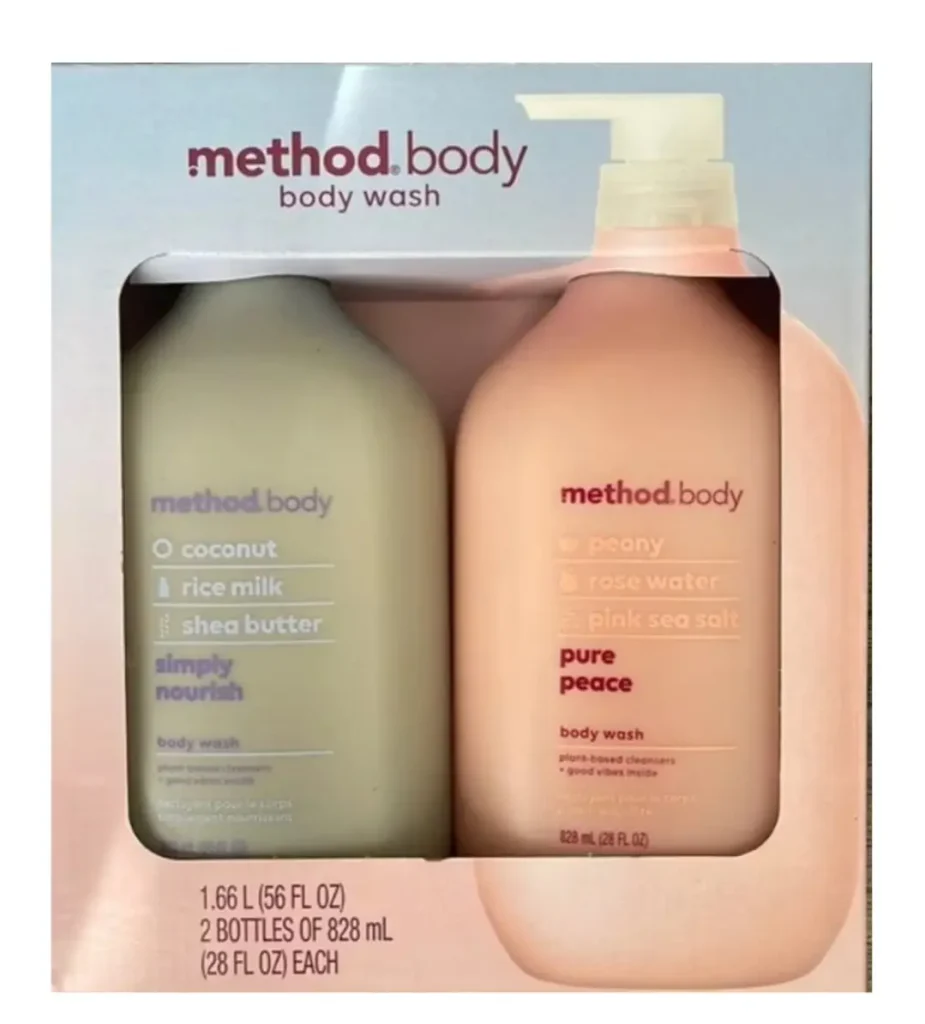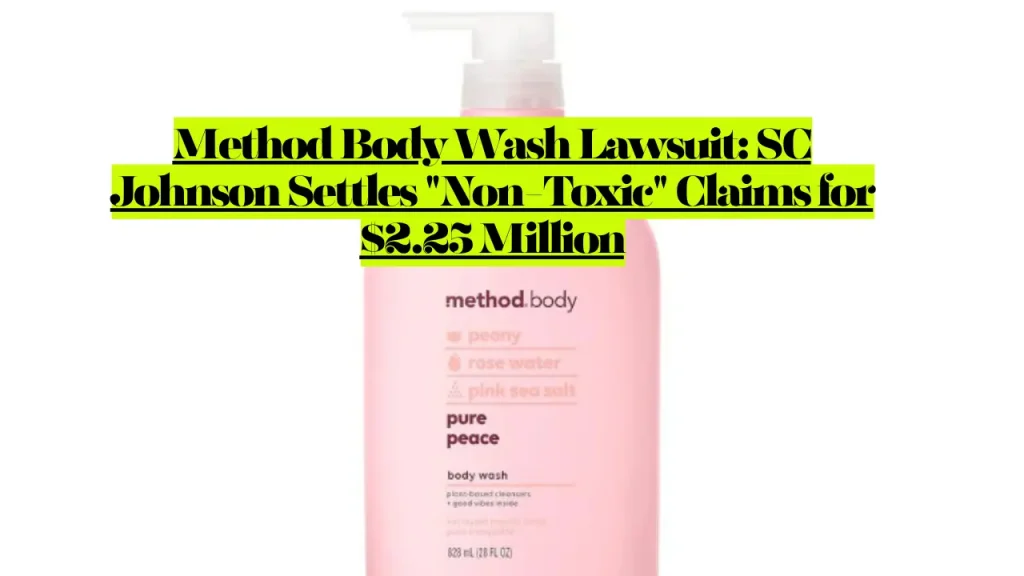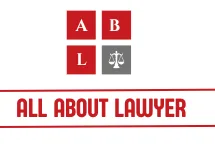Method Body Wash Lawsuit: SC Johnson Settles “Non-Toxic” Claims for $2.25 Million
SC Johnson agreed to a $2.25 million class action settlement benefiting consumers who purchased Method products labeled as “non-toxic” between May 2016 and May 2021. The lawsuit challenged marketing claims across Method’s cleaning and personal care product lines, including body washes, hand soaps, and all-purpose cleaners.
The case alleged that Method products contained harmful ingredients like methylisothiazolinone, phenoxyethanol, limonene, and dipropylene glycol, making the “non-toxic” label false and misleading. Eligible consumers could claim up to $10 without proof of purchase before the November 2021 deadline.
What Products Were Included in the Method Lawsuit?
The settlement covered 20 specific Method products with “non-toxic” labels purchased between May 14, 2016, and May 13, 2021. These included:
- Method All-Purpose Cleaners (including pet-specific formulas)
- Method Cleaning Wipes
- Method Floor Cleaners
- Method Bathroom Cleaners
- Method Dish Soaps (Smarty Dish, PowerDish)
- Method Daily Granite Cleaner
- Method Stainless Steel Polish
While the lawsuit specifically mentioned personal care products including hand washes and body products, the settlement primarily focused on cleaning products with “non-toxic” labels.

What Were the Legal Claims Against Method?
California resident Felicia Toth filed the initial lawsuit arguing that Method’s “non-toxic” representations were false because the products contained several toxic ingredients.
The complaint outlined specific chemical concerns:
Methylisothiazolinone (MI): A preservative known to cause skin sensitization and severe allergic reactions, which the European Union has restricted in leave-on products.
Phenoxyethanol: A synthetic ingredient that can cause irritation to eyes, skin, and respiratory tract.
Limonene: Found in multiple Method cleaners, this ingredient reportedly causes skin irritation characterized by burning, itching, and long-lasting rashes.
Dipropylene Glycol: A synthetic fragrance ingredient shown to cause temporary eye irritation.
The lawsuit argued that a reasonable consumer’s understanding of “non-toxic” includes products that won’t cause various types of temporary physical illness, such as vomiting or rashes.
Who Was Eligible for the Method Settlement?
Anyone living in the United States who purchased covered Method products with “non-toxic” labels between May 14, 2016, and May 13, 2021, for personal use qualified as class members.
Settlement benefits included:
- Without proof of purchase: $1 per product, maximum $10 per household
- With proof of purchase: $1 per product with valid documentation
Accepted proof included itemized store receipts, loyalty card printouts, original UPC codes, and UPC code photographs.
What Was the Settlement Timeline?
Key dates for the Method settlement:
- October 18, 2021: Deadline to opt out or object
- November 1, 2021: Final deadline to submit claims
- November 16, 2021: Final fairness hearing
The settlement required SC Johnson to stop advertising covered Method products as “non-toxic”, representing a significant shift in the company’s marketing approach.
How Did Method Respond to the Lawsuit?
SC Johnson settled the case for $2.25 million without admitting wrongdoing, allowing consumers to claim refunds while avoiding prolonged litigation.
As part of the settlement, Method agreed to stop using the word “non-toxic” to describe the brand and its products. The company shifted to more specific language like “made without parabens or phthalates.”
Since the settlement, Method has moved away from broad “non-toxic” or “natural” claims, potentially reducing greenwashing compared to their previous marketing.
What Ingredients Are Actually in Method Products?
Method products are free from parabens and phthalates, two concerning classes of chemicals that are endocrine disruptors. However, they contain other ingredients that raise questions:
Sodium Lauryl Sulfate (SLS): A surfactant that helps with cleaning but can irritate some users, especially in improper concentrations.
Isothiazolinone Preservatives: Synthetic preservatives like methylisothiazolinone are sensitizers that can cause allergic contact dermatitis.
Fragrance: Method doesn’t disclose specific fragrance ingredients, making it impossible for consumers to fully assess safety risks.
Allergens: Even naturally-derived ingredients like limonene or hexyl cinnamal can cause problems for those with allergies.

Are Method Body Washes Safe to Use?
Method body washes are marketed as naturally derived products free from parabens and phthalates. Safety ratings vary:
SkinSAFE reviewed Method’s Pure Peace and Wind Down body washes, finding them 82% top allergen-free and free of gluten, nickel, and lanolin.
EWG Skin Deep gave low hazard ratings to Method’s Energy Boost and Simply Nourish body washes.
However, individual reactions vary. Discussions on Reddit reveal mixed experiences, with some users reporting breakouts after use, especially those with sensitive skin.
What Should Consumers Do Now?
For those who purchased Method products during the settlement period, the claims deadline has passed. However, consumers can still:
Review product labels carefully: Method now uses more specific claims like “free from parabens and phthalates” rather than broad “non-toxic” statements.
Check ingredient lists: Look for specific chemicals that may trigger sensitivities, particularly if you have allergies or skin conditions.
Consider alternatives: For individuals with sensitivities, genuinely non-toxic alternatives may provide better options than Method’s current formulations.
Report adverse reactions: Contact the manufacturer and consider filing reports with consumer protection agencies if products cause health issues.
What Are Consumer Rights Regarding Product Labeling?
This lawsuit highlights important consumer protection issues:
The case argued that products marketed as “non-toxic” must live up to reasonable consumer expectations, not just meet minimum safety standards.
The settlement sent a clear message about misleading environmental marketing, though critics argue the $2.25 million penalty was minimal compared to Method’s annual revenue.
Consumers have legal protections when companies make false or misleading claims:
- Federal Trade Commission (FTC) regulations against deceptive advertising
- State consumer protection laws
- Class action lawsuit rights for widespread deceptive practices
- Private legal action for damages from misleading claims
How Does This Compare to Similar Lawsuits?
Method faced another settlement in 2017, agreeing to a $2.8 million fund for claims that Method and Ecover products were falsely marketed as “natural”.
Multiple class-action lawsuits have challenged household cleaners marketed as “non-toxic,” including cases involving Windex and other major brands.
These cases demonstrate a pattern of consumer protection enforcement against greenwashing in the cleaning products industry.
What Changed After the Settlement?
Method stopped using “non-toxic” in their branding and shifted to more specific ingredient claims. The company now emphasizes:
- Products made without parabens or phthalates
- Plant-based cleansers (with specifics about percentage)
- Cruelty-free and PETA certifications
- Biodegradable formulations
The settlement required Method to be more transparent about ingredients and claims, though critics question whether the changes go far enough.
Common Mistakes Consumers Make
When evaluating “green” cleaning products:
Assuming “natural” means safe: Even naturally-derived ingredients can cause allergic reactions or irritation in sensitive individuals.
Ignoring ingredient lists: Marketing claims don’t tell the whole story. Always review the actual ingredients.
Not testing products first: For those with sensitivities, patch testing new products prevents adverse reactions.
Believing all eco-friendly claims: Greenwashing remains common in the industry, with companies making environmental claims that don’t reflect actual product formulations.
What Recent Developments Affect Method Products?
In June 2024, SC Johnson (Method’s parent company) faced an advertising challenge from the National Advertising Division regarding claims for Native brand products, demonstrating ongoing scrutiny of personal care product marketing.
This indicates continued regulatory attention to how companies market cleaning and personal care products.
Frequently Asked Questions
What was the Method body wash lawsuit about?
The lawsuit challenged Method products marketed as “non-toxic” when they allegedly contained harmful ingredients like methylisothiazolinone, phenoxyethanol, and limonene that could harm humans or the environment.
Who was eligible to participate in the Method settlement?
Anyone in the United States who purchased covered Method products with “non-toxic” labels between May 14, 2016, and May 13, 2021, for personal use qualified for the settlement.
How much compensation was available?
Class members could claim $1 per product without proof of purchase (maximum $10 per household) or $1 per product with valid proof of purchase.
Are Method body washes safe?
Method body washes are generally considered safe and received positive safety ratings from SkinSAFE and EWG Skin Deep. However, some users with sensitive skin report adverse reactions.
Can I still file a claim for the Method settlement?
No. The deadline to submit claims was November 1, 2021. The settlement is now closed.
What changes did Method make after the lawsuit?
Method agreed to stop advertising covered products as “non-toxic” and shifted to more specific ingredient-based claims.
What ingredients should I avoid in Method products?
Individuals with sensitivities should watch for sodium lauryl sulfate, methylisothiazolinone, undisclosed fragrance ingredients, and known allergens like limonene.
Disclaimer: This information is for educational purposes only and does not constitute legal advice. Lawsuit details, eligibility criteria, settlement terms, and consumer rights may vary based on individual circumstances. Consult official court documents, review settlement terms independently, and contact the settlement administrator or an attorney for specific questions about claim eligibility or participation. The settlement deadline has passed, and this article provides historical information about the case.
Related Articles
- What Can Be Used Against You in Child Custody Cases
- Consumer Protection Attorney Who Handles Identity Theft Cases
- Which Government Bodies Make Consumer Protection Laws
About the Author

Sarah Klein, JD, is a licensed attorney and legal content strategist with over 12 years of experience across civil, criminal, family, and regulatory law. At All About Lawyer, she covers a wide range of legal topics — from high-profile lawsuits and courtroom stories to state traffic laws and everyday legal questions — all with a focus on accuracy, clarity, and public understanding.
Her writing blends real legal insight with plain-English explanations, helping readers stay informed and legally aware.
Read more about Sarah
